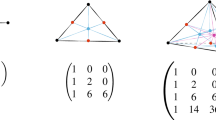Abstract
Measure homology is a variation of singular homology designed by Thurston in his discussion of simplicial volume. Zastrow and Hansen showed independently that singular homology (with real coefficients) and measure homology coincide algebraically on the category of CW-complexes. It is the aim of this paper to prove that this isomorphism is isometric with respect to the ℓ1-seminorm on singular homology and the seminorm on measure homology induced by the total variation. This, in particular, implies that one can calculate the simplicial volume via measure homology – as already claimed by Thurston. For example, measure homology can be used to prove Gromov's proportionality principle of simplicial volume.
Similar content being viewed by others
References
Benedetti, R., Petronio, C.: Lectures on Hyperbolic Geometry. Universitext, Springer, 1992
Brooks, R.: Some remarks on bounded cohomology. In: Riemann surfaces and related topics: Proceedings of the 1978 Stony Brook Conference, Ann. Math. Studies, 97, Princeton University Press, Princeton, 1981, pp. 53–63
Dugundji, J.: Topology. Allyn and Bacon, Inc., Boston, 1966
Gromov, M.: Volume and bounded cohomology. Publ. Math. IHES 56, 5–99 (1982)
Gromov, M.: Metric Structures for Riemannian and Non-Riemannian Spaces with appendices by M. Katz, P. Pansu and S. Semmes, translated from the French by Sean Michael Bates. Volume 152 of Progress in Mathematics, Birkhäuser, 1999
Hansen, S.K.: Measure homology. Math. Scand. 83(2), 205–219 (1998)
Ivanov, N.V.: Foundations of the theory of bounded cohomology. J. Soviet Math. 37, 1090–1114 (1987)
Lee, J.M.: Introduction to Smooth Manifolds. Volume 218 of Graduate Texts in Mathematics, Springer, 2003
Massey, W.S.: A Basic Course in Algebraic Topology. Volume 127 of Graduate Texts in Mathematics, Springer, 1991
Mitsumatsu, Y.: Bounded cohomology and ℓ1-homology of surfaces. Topology 23(4), 465–471 (1984)
Monod, N.: Contiuous Bounded Cohomology of Locally Compact Groups. Volume 1758 of Lecture Notes in Mathematics, Springer, 2001
Munkholm, H.J.: Simplices of maximal volume in hyperbolic space, Gromov's norm, and Gromov's proof of Mostow's rigidity theorem (following Thurston). In: Topology Symposium, Siegen 1979, Volume 788 of Lecture Notes in Mathematics, Springer, 1980, pp. 109–124
Ratcliffe, J.G.: Foundations of Hyperbolic Manifolds. Volume 149 of Graduate Texts in Mathematics, Springer, 1994
Strohm, C.: (= C. Löh). The Proportionality Principle of Simplicial Volume, Diploma thesis, Universität Münster, 2004. Available online at: arXiv:math.AT/0504106
Thurston, W.P.: Geometry and Topology of 3-Manifolds. Lecture notes, Princeton, 1978. Available at http://www.msri.org/publications/books/gt3m. Don't miss the train tracks on page 8.51
Zastrow, A.: On the (non)-coincidence of Milnor-Thurston homology theory with singular homology theory. Pacific J. Math. 186(2), 369–396 (1998)
Author information
Authors and Affiliations
Corresponding author
Rights and permissions
About this article
Cite this article
Löh, C. Measure homology and singular homology are isometrically isomorphic. Math. Z. 253, 197–218 (2006). https://doi.org/10.1007/s00209-005-0905-7
Received:
Accepted:
Published:
Issue Date:
DOI: https://doi.org/10.1007/s00209-005-0905-7




